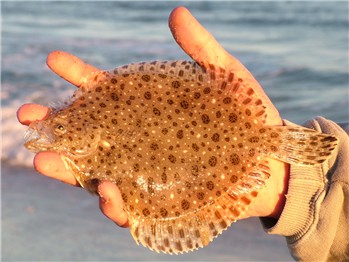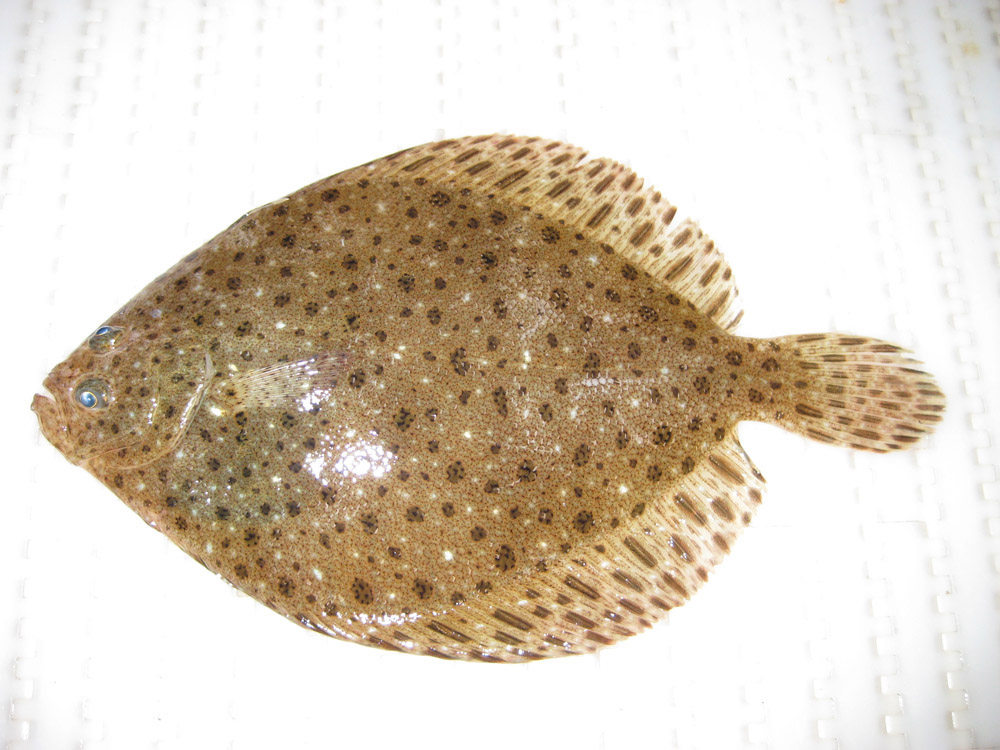
Scophthalmus aquosus
FAMILY
Scophthalmidae
TAXONOMY
Pleuronectes aquosus Mitchill, 1815, New York, United States.
OTHER COMMON NAMES
English: Sand dab; spotted flounder, brill; French: Turbot de
sable.
PHYSICAL CHARACTERISTICS
Medium-sized, sinistral flatfish characterized by a deep, nearly
round, thin, and almost translucent body with a rounded caudal
fin. The head is small with a relatively large mouth having
a wide gape and with a projecting lower jaw that has a knob on
its ventral surface. Small teeth are present on both jaws. The
first 10–12 fin rays of the dorsal fin are free from the fin membrane
along the distal half and branched toward their tips,
forming a conspicuous fringe. Eyes are large, separated, and
nearly equal in position on the head. Pelvic fin bases are elongated
and slightly asymmetrical. Scales are cycloid and smooth
to the touch. The lateral line is strongly arched above the pectoral
fin. The ocular side is rather translucent greenish olive or
slightly reddish brown or pale slate-brown, mottled with
darker and paler irregular markings and usually dotted with
many small, irregularly shaped brown spots and sometimes also
with white spots that vary in size. Blind side is generally
whitish, occasionally with some irregular darker blotches. Can
reach sizes to about 15.7 in (40 cm) and weights to about 2.2
lb (1 kg), but adults typically average only 9.8–11.8 in (25–30
cm). Can live to be 15–18 years of age, but most individuals
are 11 years old or younger.
DISTRIBUTION
Western North Atlantic in lower estuarine and marine waters
on the inner continental shelf of eastern North America from
the Gulf of Saint Lawrence to Florida. Most abundant from
Georges Bank to Chesapeake Bay.
HABITAT
Shallow, inshore waters from the high tide line down to about
656 ft (200 m), with the greatest numbers occurring at depths
of less than 180 ft (55 m). They occur most often on sandy
bottoms but also can be found on softer and muddier sediments.
BEHAVIOR
Diurnally active. Often lie on or within sandy sediments.
Young windowpane flounder settle in shallow water inshore
and tend to move into deeper offshore waters as they grow.
Adults may undertake movements along the coast for considerable
distances (80 mi, or 129 km, in three months) or even
move across open water.
FEEDING ECOLOGY AND DIET
Visually oriented, ambush predators that forage on a variety of
actively swimming prey, particularly mysids, various fishes, and
decapod crustaceans, especially shrimp. They also eat chaetognaths,
squids, mollusks, ascidians, polychaetes isopods, amphipods,
euphausiids, and salps. Windowpane flounders, in
turn, are eaten by various sharks, skates, stingrays, codfish, cobia,
bluefish, and other windowpane flounders.
REPRODUCTIVE BIOLOGY
Windowpane flounder of both sexes mature at about the same
size, 8.3–8.7 in (21–22 cm) between ages three and four years,
with males sometimes maturing at age two. Spawning occurs
from February to November, with peak spawning from May
through October. There is a strong correlation between water
temperatures and spawning. They spawn in the evening or at
night on or near the bottom at temperatures from 42.8 to
69.8°F (6–21°C), with optimal spawning temperatures of
60.8–66.2°F (16–19°C) in the Mid-Atlantic Bight and
55.4–60.8°F (13–16°C) on Georges Bank. Eggs are transparent,
have an oil globule, and are buoyant. Larvae hatch at 0.07–0.09
in (1.8–2.3 mm), usually at eight days post-spawning in temperatures
of 50–55.4°F (10–13°C). Eye migration begins when
they reach a length of about 0.26 in (6.5 mm), proceeds very
rapidly, and typically is completed by 0.39–0.51 (10–13 mm)
total length.
CONSERVATION STATUS
Not threatened.
SIGNIFICANCE TO HUMANS
Not commercially important and not targeted directly by commercial
fisheries. They often are taken as by-catch during trawl
fishing.
Photo Gallery of - Windowpane flounder





 Animalia Life
Animalia Life